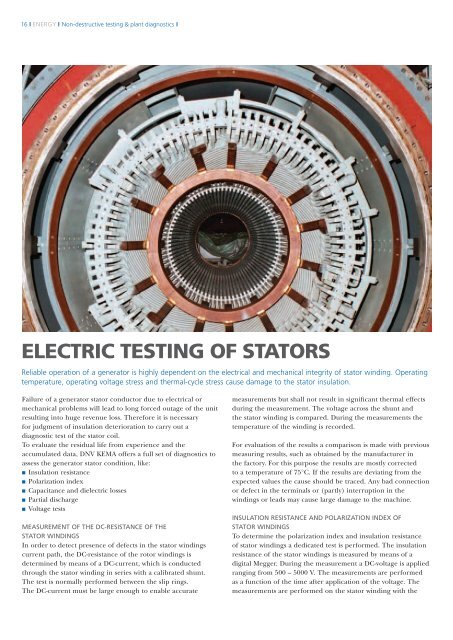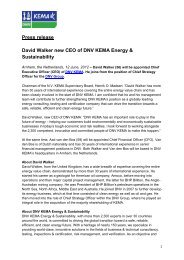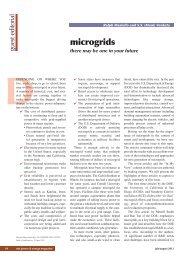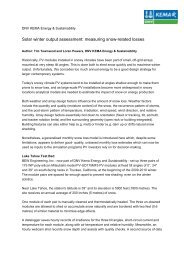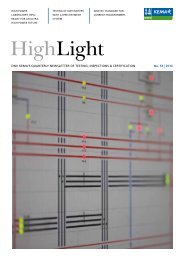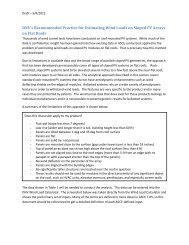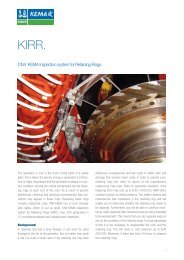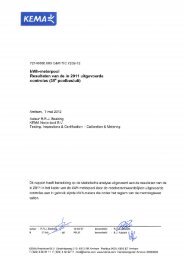Diagnostics and testing of rotating electrical machines - DNV Kema
Diagnostics and testing of rotating electrical machines - DNV Kema
Diagnostics and testing of rotating electrical machines - DNV Kema
You also want an ePaper? Increase the reach of your titles
YUMPU automatically turns print PDFs into web optimized ePapers that Google loves.
16<br />
ENERGY Non-destructive <strong>testing</strong> & plant diagnostics<br />
Electric <strong>testing</strong> <strong>of</strong> stators<br />
Reliable operation <strong>of</strong> a generator is highly dependent on the <strong>electrical</strong> <strong>and</strong> mechanical integrity <strong>of</strong> stator winding. Operating<br />
temperature, operating voltage stress <strong>and</strong> thermal-cycle stress cause damage to the stator insulation.<br />
Failure <strong>of</strong> a generator stator conductor due to <strong>electrical</strong> or<br />
mechanical problems will lead to long forced outage <strong>of</strong> the unit<br />
resulting into huge revenue loss. Therefore it is necessary<br />
for judgment <strong>of</strong> insulation deterioration to carry out a<br />
diagnostic test <strong>of</strong> the stator coil.<br />
To evaluate the residual life from experience <strong>and</strong> the<br />
accumulated data, <strong>DNV</strong> KEMA <strong>of</strong>fers a full set <strong>of</strong> diagnostics to<br />
assess the generator stator condition, like:<br />
■■<br />
Insulation resistance<br />
■■<br />
Polarization index<br />
■■<br />
Capacitance <strong>and</strong> dielectric losses<br />
■■<br />
Partial discharge<br />
■■<br />
Voltage tests<br />
Measurement <strong>of</strong> the DC-resistance <strong>of</strong> the<br />
stator windings<br />
In order to detect presence <strong>of</strong> defects in the stator windings<br />
current path, the DC-resistance <strong>of</strong> the rotor windings is<br />
determined by means <strong>of</strong> a DC-current, which is conducted<br />
through the stator winding in series with a calibrated shunt.<br />
The test is normally performed between the slip rings.<br />
The DC-current must be large enough to enable accurate<br />
measurements but shall not result in significant thermal effects<br />
during the measurement. The voltage across the shunt <strong>and</strong><br />
the stator winding is compared. During the measurements the<br />
temperature <strong>of</strong> the winding is recorded.<br />
For evaluation <strong>of</strong> the results a comparison is made with previous<br />
measuring results, such as obtained by the manufacturer in<br />
the factory. For this purpose the results are mostly corrected<br />
to a temperature <strong>of</strong> 75°C. If the results are deviating from the<br />
expected values the cause should be traced. Any bad connection<br />
or defect in the terminals or (partly) interruption in the<br />
windings or leads may cause large damage to the machine.<br />
Insulation resistance <strong>and</strong> polarization index <strong>of</strong><br />
stator windings<br />
To determine the polarization index <strong>and</strong> insulation resistance<br />
<strong>of</strong> stator windings a dedicated test is performed. The insulation<br />
resistance <strong>of</strong> the stator windings is measured by means <strong>of</strong> a<br />
digital Megger. During the measurement a DC-voltage is applied<br />
ranging from 500 – 5000 V. The measurements are performed<br />
as a function <strong>of</strong> the time after application <strong>of</strong> the voltage. The<br />
measurements are performed on the stator winding with the


